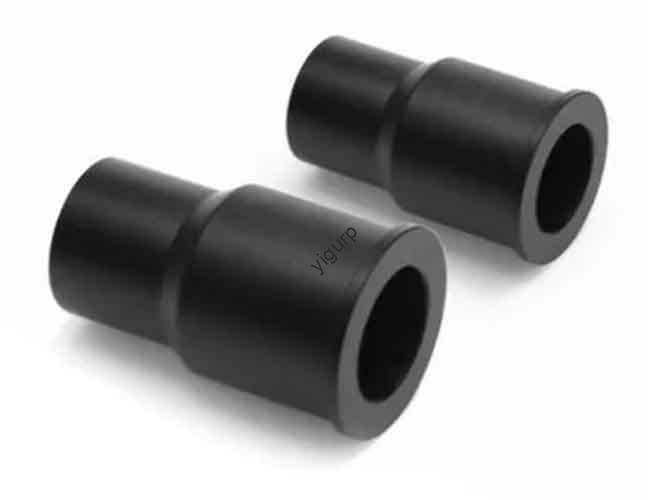When developing a water purifier, the prototype phase directly determines whether the final product meets user needs and industry standards. Among all prototype manufacturing methods, Usinagem CNC stands out for its precision and reliability—but why is it indispensable for water purifier prototypes? This article breaks down key aspects of CNC-machined water purifier prototypes, from design to testing, to help you understand its value.
1. Core Design Principles for CNC-Machined Water Purifier Prototypes
A successful prototype starts with design optimization tailored to CNC capabilities. Below are three non-negotiable design focuses:
| Design Aspect | Requisitos -chave | CNC Compatibility Note |
| Functional Design | – Smooth internal water flow channels (no dead ends).- Tight filter element interfaces (for PP cotton, RO membranes, etc.). | CNC’s high precision ensures channel dimensions match filter sizes exactly. |
| Structural Strength | – Uniform shell thickness (to resist 0.3–0.6MPa water pressure).- Reasonable support structures (Por exemplo, stiffeners). | CNC simulates real-use pressure via consistent material removal. |
| Maintainability | – Modular parts (removable panels, easy filter access). | CNC enables precise cutting of assembly clearances (avoids loose/tight fits). |
2. What Advantages Does CNC Machining Offer for Water Purifier Prototypes?
Compared to 3D printing or manual machining, CNC machining provides unique benefits that directly improve prototype quality. Aqui está uma comparação lado a lado:
| Categoria de vantagem | CNC Machining Performance | 3D Printing Limitation |
| Precisão | Dimensional precision up to ± 0,05 mm (ideal for fine holes like water inlets). | Typical precision of ±0.1–0.3mm (risk of leaky joints). |
| Versatilidade material | Processes plastics (Abs, acrílico), liga de alumínio, e cobre. | Limited to plastic filaments (poor for metal waterway tests). |
| Acabamento superficial | Supports post-treatment (spraying, revestimento) for mass-production simulation. | Superfície áspera (requires extra sanding; hard to replicate factory textures). |
3. Step-by-Step CNC Machining Process for Water Purifier Prototypes
CNC machining follows a linear, repeatable workflow to ensure consistency. The process is divided into 5 Principais estágios:
- Model Splitting & Programação
Split the 3D model into machinable parts (Por exemplo, concha, liner, filter holder). Select tools (high-precision ball nose cutters for curves) and optimize parameters (rotational speed, taxa de alimentação) to reduce material deformation.
- Desbaste
Quickly remove 90% de excesso de material, deixando a 0.5–1mm allowance para acabamento. This step saves time while protecting the final shape.
- Acabamento
Use low-feed, high-speed cutting to achieve a surface roughness of Ra0.8–Ra3.2—critical for smooth water flow and user comfort (sem arestas vivas).
- Special Structure Treatment
- Threaded/mounting holes: Machined via spiral milling to prevent slippage.
- Complex curved surfaces: Achieved via 5-axis CNC for seamless waterway connections.
- Ligação & Conjunto
Use epoxy or instant adhesive to simulate mass-production methods (Por exemplo, Snaps, parafusos), testing real-world assembly logic.
4. Material Selection Guide for CNC-Machined Prototypes
Choosing the right material directly impacts prototype performance. Below is a practical material-scenario match:
| Tipo de material | Applicable Prototype Parts | Principais recursos |
| Plástico ABS | Concha, painel de controle | Easy to polish/plate; baixo custo; mimics mass-produced plastics. |
| Transparent Acrylic | Tanque de água, internal viewing window | Alta transparência; allows observation of water flow. |
| Liga de alumínio | Internal brackets, waterway joints | Leve, resistente à corrosão; ideal for metal part testing. |
| Nylon | Filter element card slots | Self-lubricating, resistente ao desgaste; easy to test filter replacement. |
5. Pós-tratamento & Teste funcional
Um protótipo CNC só é válido se passar por rigoroso pós-processamento e testes para simular o uso real.
Key Post-Treatments
- Moagem/polimento: Remove marcas de faca (crítico para a sensação das conchas de plástico).
- Limpeza ultrassônica: Elimina fluido de corte residual (evita contaminação de cursos de água).
- Tratamentos de Simulação:
- Pulverização (Por exemplo, preto fosco/branco) para replicar texturas de fábrica.
- Triagem de seda (Logos, rótulos de parâmetros) para facilidade de uso.
- Revestimento (brilho de aço inoxidável) para peças de metal.
Must-Perform Tests
| Tipo de teste | Propósito | Critérios de aprovação |
| Verificação de montagem | Verifique a instalação do filtro, encaixe de tubo, e usabilidade de botão/tela. | Substituição suave do filtro; visualização clara da tela. |
| Teste de fluxo de água | Verify waterway efficiency (use dye/flow meter) and leak resistance. | No leaks at 0.3–0.6MPa; uniform water flow. |
| Weathering Test | Simulate long-term use. | No plastic discoloration (UV test); no metal rust (corrosion test). |
6. Yigu Technology’s Perspective on CNC Machined Water Purifier Prototypes
Na tecnologia Yigu, we believe CNC machining is the cornerstone of reliable water purifier development. Ao contrário da impressão 3D, CNC’s ±0.05mm precision solves common prototype pain points—such as leaky waterways or loose filter slots—that could derail mass production. We often recommend clients prioritize CNC for core parts (conchas, waterway liners) while using 3D printing for non-critical components to balance cost and quality. Por exemplo, a recent project using CNC-machined aluminum liners and ABS shells reduced pressure loss by 15% and cut filter replacement time in half. Em última análise, CNC prototypes don’t just test design—they accelerate the path from concept to market.
Perguntas frequentes
- How much does a CNC-machined water purifier prototype cost?
The cost ranges from 500 para 3,000 yuan per unit, depending on part complexity and material. To control costs, focus on machining key components (Por exemplo, conchas) and use 3D printing for secondary parts.
- How long does it take to make a CNC-machined water purifier prototype?
Typically 5–15 days. For faster turnaround, split complex parts into smaller components and process them in parallel.
- Can CNC machining simulate all mass-production features of a water purifier?
Yes—CNC supports post-treatments like spraying, revestimento, and silk screening to replicate factory finishes. It also tests assembly logic (Por exemplo, Snaps, parafusos) that match mass-production methods.
